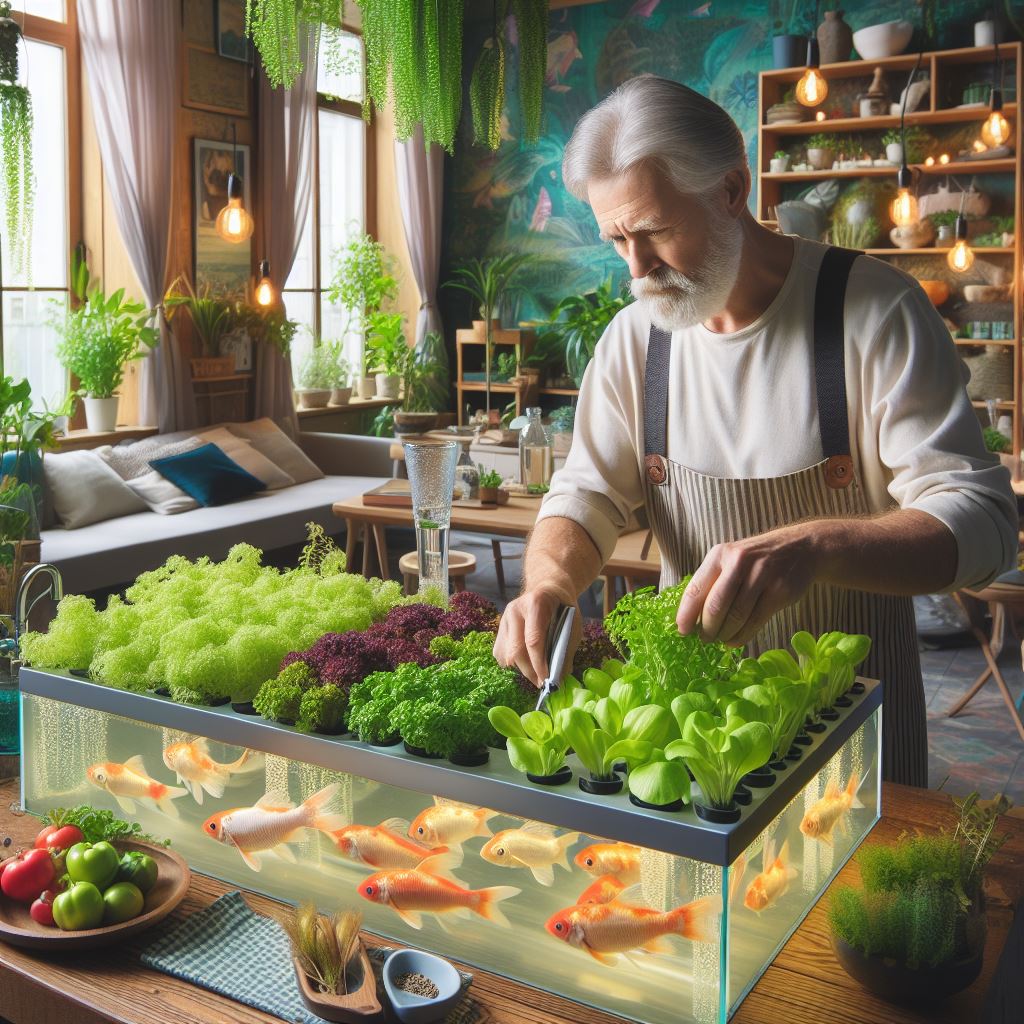Apartment Aquaponics: Fish & Plants
Last Updated on March 2, 2024
Introduction
In today’s world, sustainable and indoor farming methods have become increasingly important.
One such technique is aquaponics, which combines fish farming with plant cultivation.
Aquaponics is a sustainable farming technique that utilizes a closed-loop system.
It involves the cultivation of fish and plants together, creating a mutually beneficial relationship.
In this system, the fish waste provides nutrients for the plants, while the plants help to purify the water for the fish.
This eliminates the need for chemical fertilizers and ensures efficient use of resources.
One major advantage of aquaponics is its ability to be practiced indoors, making it suitable for urban areas with limited space.
By using vertical farming techniques, multiple layers of plants can be grown in the same space, maximizing productivity.
Additionally, aquaponics systems require less water compared to traditional farming methods.
The water is continuously recirculated, reducing waste and conserving this precious resource.
Furthermore, aquaponics eliminates the need for pesticides and herbicides, making it an organic and eco-friendly farming technique.
This ensures the production of clean and healthy food.
Basically, aquaponics is a sustainable and indoor farming technique that combines fish farming with plant cultivation.
It offers numerous advantages, including efficient resource utilization, space optimization, water conservation, and organic food production.
What is Apartment Aquaponics?
Definition and explanation of apartment aquaponics
Apartment aquaponics can revolutionize the way urban dwellers approach food production.
By efficiently utilizing the limited space available in apartments, this innovative system allows individuals to grow their own produce and rear fish in a sustainable and symbiotic manner.
Through the combination of aquaculture and hydroponics, people have the opportunity to create a self-sustaining ecosystem that provides fresh food right at their fingertips.
Benefits of apartment aquaponics
Space-saving solution for urban dwellers
One of the key benefits of apartment aquaponics is its space-saving nature.
In densely populated areas where green space is scarce, having a traditional garden is often not feasible.
However, with apartment aquaponics, individuals can transform their balconies, patios, or even unused corners of their homes into productive food-growing areas.
This opens up a world of possibilities for urban dwellers who crave the satisfaction of growing their own food but lack the necessary space.
Economic and environmental advantages
Apart from the space-saving aspect, apartment aquaponics also offers economic and environmental advantages.
By growing their own produce, individuals can significantly reduce their grocery bills while enjoying the freshness and quality of homegrown vegetables.
Additionally, apartment aquaponics eliminates the need for long-distance transport of produce, reducing carbon emissions and contributing to a greener environment.
Opportunity for fresh produce and fish in apartments
The self-sustaining nature of aquaponics means that apartment dwellers can not only grow their own vegetables but also rear fish.
By combining fish farming (aquaculture) with soilless plant cultivation (hydroponics), apartment aquaponics creates a mutually beneficial relationship between the fish and plants.
Waste produced by the fish provides the necessary nutrients for plant growth, while the plants naturally filter and clean the water for the fish.
This symbiotic relationship ensures the overall health and productivity of the system.
Educational value for families and individuals
Apart from the practical benefits, apartment aquaponics also holds educational value, especially for families and individuals.
It can serve as a valuable teaching tool for children to learn about biology, food production, and the importance of sustainable practices.
It fosters a deeper understanding of the interconnectivity of ecosystems and the delicate balance required to create a sustainable and thriving environment.
In general, apartment aquaponics offers a sustainable and space-saving solution for urban dwellers.
It presents economic and environmental advantages, provides fresh produce and fish right in apartments, and offers educational value for families and individuals.
With apartment aquaponics, anyone can embark on a journey of self-sufficiency while contributing to a greener and more sustainable future.
Read: Urban Chicken Coops: Fresh Eggs Daily
Getting Started with Apartment Aquaponics
Apartment aquaponics is a unique way to bring the benefits of aquaponics to smaller living spaces.
Whether you’re in a studio apartment or a cozy condo, you can still enjoy the wonders of growing your own food and raising fish in a sustainable and symbiotic ecosystem.
In this section, we will guide you through the initial steps of getting started with apartment aquaponics, from determining the available space to selecting the right fish and plants, and setting up the necessary equipment.
Determining available space and choosing a setup
- When it comes to apartment aquaponics, it’s crucial to assess the available space and select a suitable setup. Fortunately, there are various options for small and indoor aquaponics systems. You can find compact designs that can fit on a countertop or wall-mounted systems that utilize vertical space efficiently.
- Additionally, it’s essential to consider any apartment-specific limitations. For instance, if you’re renting, you may need to abide by certain weight restrictions or obtain permission from your landlord. Take measurements of the available floor area and consider whether a freestanding or built-in aquaponics system would work best for your space.
Choosing the right fish and plants for apartment aquaponics
- Selecting the ideal fish species is crucial for the success of your small-scale aquaponics system. Some fish thrive in confined spaces and require minimal maintenance. Betta fish and goldfish are popular choices for apartment aquaponics.
- Apart from fish, you’ll also want to choose suitable plants for indoor farming. Herbs like basil, mint, and parsley are excellent options due to their fast growth and compact size. Leafy greens such as lettuce and spinach are also well-suited for this type of setup.
- It’s crucial to consider the compatibility between the chosen fish and plants. Certain plants may require specific water conditions or nutrient levels, so ensure they can coexist harmoniously with your chosen fish species. This will help create a balanced ecosystem and maximize the benefits of aquaponics.
Setting up the aquarium and grow bed
- To set up your apartment aquaponics system, you’ll need some essential equipment and materials. These typically include an aquarium or tank to house the fish, a grow bed for the plants, a water pump, and appropriate tubing to connect everything.
- Follow a step-by-step guide to assemble your aquaponics system. Start by placing the aquarium and grow bed in the designated location, ensuring they are stable and level. Then, connect the two components using the tubing, allowing water to flow from the fish tank to the grow bed.
- Proper water circulation and filtration are vital for the health of both your fish and plants. Make sure to set up a reliable water pump and filtration system to maintain optimal water quality. This will help remove any waste from the fish and provide the necessary nutrients to the plants.
By following these steps, you can successfully get started with apartment aquaponics.
Remember to regularly monitor water parameters, feed the fish appropriately, and harvest your fresh produce when it’s ready.
Enjoy the benefits of this sustainable and rewarding gardening method right in your own apartment!
Read: Window Box Farming: Herbs and Flowers
Maintaining and Managing an Apartment Aquaponics System
Water quality management
Maintaining and managing an apartment aquaponics system requires careful attention to various aspects of the setup.
Proper water quality management is essential to ensure the well-being of both fish and plants.
To begin with, it is crucial to monitor pH levels and temperature regularly.
Fluctuations in these parameters can be detrimental to the health of the ecosystem.
By keeping an eye on these factors, necessary adjustments can be made promptly to maintain the desired conditions.
Understanding the nitrogen cycle is also vital in apartment aquaponics.
The nitrogen cycle involves the conversion of fish waste into beneficial nutrients for plants.
It is important to grasp the significance of this cycle to maintain a balanced and thriving system.
By allowing beneficial bacteria to colonize the grow beds and filters, the conversion of ammonia to nitrite and nitrate can occur, providing essential nutrients for plant growth.
Feeding and caring for the fish
Feeding and caring for the fish in an apartment aquaponics system require proper attention.
Designing appropriate feeding schedules and quantities is important to prevent overfeeding or underfeeding the fish.
Overfeeding can lead to poor water quality and potential health issues for the fish, while underfeeding can result in malnourishment.
Monitoring the fish’s health regularly ensures that they receive a balanced diet and allows for immediate identification of any signs of illness.
Nurturing and harvesting the plants
Nurturing and harvesting the plants in the system is another important aspect of maintenance.
Providing adequate lighting and necessary nutrients is essential to promote healthy plant growth.
Indoor plants rely heavily on light sources, so ensuring they receive the appropriate amount of light is crucial.
Additionally, regular pruning and harvesting techniques help maintain the plants’ productivity and prevent overcrowding.
Troubleshooting common apartment aquaponics issues
However, even with proper maintenance, apartment aquaponics systems may encounter common issues that need troubleshooting.
Addressing water quality problems promptly is essential to maintain a healthy environment.
Adjusting pH levels, removing excess waste, or introducing beneficial bacteria can help restore the balance in the system.
Pest infestations can also occur in an indoor environment.
Dealing with these pests using natural remedies or non-toxic pest control methods is important to avoid harming the fish, plants, or the overall ecosystem.
Regular monitoring and preventive measures can significantly reduce the likelihood of pest infestations.
In essence, maintaining and managing an apartment aquaponics system involves careful attention to water quality management, proper fish care, nurturing and harvesting plants, and troubleshooting issues promptly.
By addressing these aspects diligently, one can create a thriving and sustainable indoor aquaponics system.
Read: Small-Scale Farming: From Seed to Table

Uncover the Details: Vertical Veg: Climbing Plants in Containers
Tips and Best Practices for Apartment Aquaponics Success
Managing space constraints
- Prioritize compact aquaponics systems that fit well within apartment living.
- Utilize vertical space by installing hanging pots or shelves for plants.
- Opt for smaller fish breeds to minimize their space requirements.
- Consider using creative solutions like stacking grow beds or utilizing wall-mounted aquaponics systems.
Maintaining a proper balance between fish and plants
- Calculate the appropriate ratio of fish to plants to ensure optimal nutrient cycling.
- Avoid overstocking the tank, as excess fish waste can overwhelm the plant’s nutrient absorption capacity.
- Regularly monitor the nitrogen cycle to prevent ammonia and nitrite spikes.
- Adjust stocking density and feeding habits based on the growth and health of both fish and plants.
Regular monitoring and adjusting of system parameters
- Keep a close eye on water temperature, pH levels, and dissolved oxygen content.
- Use appropriate testing kits to measure the system’s water quality regularly.
- Implement necessary adjustments to maintain optimal conditions for fish and plant growth.
- Monitor the performance of pumps, filters, and other components to ensure efficient operation.
Seeking and sharing knowledge within the aquaponics community
- Join online forums and social media groups dedicated to aquaponics for valuable insights and advice.
- Attend aquaponics workshops or seminars to learn from experienced practitioners.
- Collaborate with other apartment aquaponics enthusiasts to exchange ideas and troubleshoot issues.
- Share your own experiences and lessons learned with the community to contribute to its collective knowledge.
Apartment aquaponics offers incredible potential for urban dwellers to grow their own fresh produce while raising ornamental fish.
However, it requires careful attention to various aspects to ensure success within the confines of limited space.
By following a few essential tips and best practices, apartment aquaponics can become a thriving and sustainable endeavor.
Managing space constraints
Managing space constraints is crucial in apartment aquaponics.
With limited room available, it is important to choose compact systems that fit well within an apartment setting.
Look for vertical gardening solutions such as hanging pots or shelves to maximize plant growing areas.
Additionally, opting for smaller fish breeds can help minimize space requirements without compromising the overall system balance.
Maintaining a proper balance between fish and plants
Maintaining a proper balance between fish and plants is vital for a successful aquaponics setup.
Calculate the appropriate ratio of fish to plants based on their nutrient requirements and growth rates.
Overstocking the tank can lead to excess fish waste overwhelming the plant’s ability to absorb nutrients.
Regularly monitor the nitrogen cycle and adjust stocking density and feeding habits accordingly.
Regular monitoring and adjusting of system parameters
Regular monitoring and adjusting of system parameters are crucial for the well-being of both fish and plants.
Keep a close eye on water temperature, pH levels, and dissolved oxygen content.
Regularly test water quality using appropriate kits and make necessary adjustments to maintain optimal conditions.
Also, closely monitor and maintain the performance of pumps, filters, and other components to ensure efficient and smooth operation.
Seeking and sharing knowledge within the aquaponics community
One of the most valuable resources for apartment aquaponics enthusiasts is the aquaponics community itself.
Seek knowledge by joining online forums and social media groups dedicated to aquaponics.
Engage with experienced practitioners and attend workshops or seminars to learn from their expertise.
Collaborating with other apartment aquaponics enthusiasts allows for the exchange of ideas and solutions to common challenges.
Sharing experiences and lessons learned also contributes to the community’s collective knowledge.
In a nutshell, apartment aquaponics can thrive with proper management and implementation of tips and best practices. Embrace space constraints by choosing suitable systems and utilizing vertical space creatively.
Maintain a balanced ecosystem by carefully managing the fish-to-plants ratio.
Regularly monitor and adjust system parameters, while seeking and sharing knowledge within the aquaponics community.
With these guidelines in mind, apartment dwellers can enjoy the benefits of fresh produce and ornamental fish right at home.
Read: Urban Green: Edible Plants in Pots
Conclusion
Recap of the benefits of apartment aquaponics
Apartment aquaponics offers numerous benefits for individuals living in small spaces.
By combining fish farming with plant cultivation, apartment dwellers can enjoy fresh produce and homegrown fish.
Apartment aquaponics systems are highly efficient, with the fish waste fertilizing the plants, creating a symbiotic relationship.
This method eliminates the need for chemical fertilizers, reducing environmental impact and promoting sustainable agriculture.
Additionally, apartment aquaponics enhances air quality and provides a calming effect, promoting mental well-being.
Encouragement to give apartment aquaponics a try
If you’re looking for a new and exciting way to grow your food, apartment aquaponics is worth considering.
Even with limited space, you can set up a small aquaponics system and reap the benefits.
It’s a rewarding experience that allows you to have a direct connection with your food source.
Start small, learn as you go, and enjoy the incredible flavors of homegrown vegetables and fish.
Final thoughts and future possibilities for apartment farming
The future of apartment farming looks promising as more people embrace sustainable and self-sufficient lifestyles.
Advancements in technology and design will likely make apartment aquaponics more accessible and efficient.
Imagine entire apartment complexes adorned with lush green gardens, producing fresh food for residents.
Apartment aquaponics has the potential to revolutionize urban living, providing a sustainable solution to food production.
With creativity and innovation, the possibilities for apartment farming are endless.
So why not give apartment aquaponics a try and take a step towards a sustainable future?


